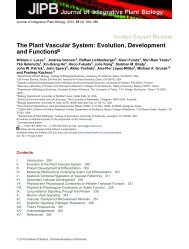Insights into the Witheringia solanacea (Solanaceae ... - BioOne
Insights into the Witheringia solanacea (Solanaceae ... - BioOne
Insights into the Witheringia solanacea (Solanaceae ... - BioOne
You also want an ePaper? Increase the reach of your titles
YUMPU automatically turns print PDFs into web optimized ePapers that Google loves.
and <strong>the</strong> Antilles to South America. It is an extremely<br />
variable species, but is distinguished by its pubescence<br />
of unbranched or sparsely branched hairs<br />
and often tetramerous flowers. Hunziker (1969)<br />
listed one variety, W. <strong>solanacea</strong> var. silvigaudens<br />
(Standl. & Williams) Hunz., endemic to Dept.<br />
Morazán, Honduras. This variety is glabrous, has<br />
pentamerous corollas, and longer, narrower leaves<br />
than typical W. <strong>solanacea</strong>. Wi<strong>the</strong>ringia asterotricha<br />
is closely related to W. <strong>solanacea</strong>, and according to<br />
Hunziker (1969), probably should be considered a<br />
variety of <strong>the</strong> latter species. Wi<strong>the</strong>ringia asterotricha,<br />
thus far known only from Costa Rica and Panama,<br />
is morphologically distinguishable from W. <strong>solanacea</strong><br />
by its dense pubescence of dendritically<br />
branched hairs and pentamerous flowers. Wi<strong>the</strong>ringia<br />
meiantha ranges from sou<strong>the</strong>rn Mexico to<br />
western Panama. Plants of W. meiantha are glabrous,<br />
with small pentamerous flowers and fewerflowered<br />
inflorescences than W. <strong>solanacea</strong> or W. asterotricha.<br />
Unlike Hunziker (1969), D’Arcy (1973) recognized<br />
only two species in <strong>the</strong> complex. He maintained<br />
W. asterotricha as distinct, but indicated that<br />
hybrids with W. <strong>solanacea</strong> may occur when <strong>the</strong> two<br />
species come <strong>into</strong> contact. D’Arcy (1973) considered<br />
W. meiantha a synonym of W. <strong>solanacea</strong>, commenting<br />
that <strong>the</strong> reduced pubescence and slightly<br />
larger calyces characterizing W. meiantha were likely<br />
minor morphological variants of <strong>the</strong> widespread<br />
W. <strong>solanacea</strong>.<br />
Nee (1986), treating only <strong>the</strong> taxa from Veracruz,<br />
Mexico, recognized W. meiantha as distinct<br />
from W. <strong>solanacea</strong> and considered W. <strong>solanacea</strong> var.<br />
silvigaudens a synonym of W. meiantha. According<br />
to Nee (1986), W. meiantha can be distinguished<br />
from W. <strong>solanacea</strong> by its larger calyx and seeds, pentamerous<br />
flowers, glabrous leaves, and few-flowered<br />
inflorescences.<br />
To gain fur<strong>the</strong>r insight <strong>into</strong> <strong>the</strong> relationships of<br />
<strong>the</strong>se taxa, I carried out a crossing study in <strong>the</strong><br />
greenhouse to determine if genetic isolating mechanisms<br />
were operating among members of <strong>the</strong> W.<br />
<strong>solanacea</strong> complex. It was also of interest to examine<br />
breeding systems of <strong>the</strong> three taxa, as no<br />
information of this kind is available for Wi<strong>the</strong>ringia,<br />
and <strong>the</strong> distribution of self-incompatibility (SI)<br />
among genera of <strong>the</strong> Solaneae is not well known.<br />
Greenhouse plants were grown from seed collections<br />
(accessions) of three sites in Costa Rica. Costa<br />
Rica, and perhaps Panama, are <strong>the</strong> most likely areas<br />
of sympatry or near sympatry for <strong>the</strong> three species,<br />
and <strong>the</strong>refore represent localities in which repro-<br />
Crossing Studies in Wi<strong>the</strong>ringia 71<br />
ductive interaction among <strong>the</strong> taxa is at least <strong>the</strong>oretically<br />
possible.<br />
In addition to <strong>the</strong> crossing results, a brief key<br />
to <strong>the</strong> three entities is included at <strong>the</strong> conclusion<br />
of <strong>the</strong> paper. A complete systematic treatment of<br />
<strong>the</strong> genus Wi<strong>the</strong>ringia is being prepared by M. Sousa-Peña<br />
of <strong>the</strong> University of Connecticut.<br />
MORPHOLOGY<br />
The three taxa of <strong>the</strong> complex are all erect herbs,<br />
weakly woody shrubs, or small trees reaching several<br />
meters in height. The leaves are entire, elliptic,<br />
unequal in size, and paired at <strong>the</strong> nodes (Fig. 1A).<br />
All three taxa lack obvious peduncles, and as a result,<br />
flowers are clustered in axillary fascicles (Fig.<br />
1). The corollas are stellate and light yellowish to<br />
cream in color, with those of W. meiantha smaller<br />
and deeper yellow than those of W. asterotricha and<br />
W. <strong>solanacea</strong>. The latter two taxa often have greenish<br />
maculations in <strong>the</strong> corolla throat, and <strong>the</strong> corolla<br />
lobes are longer and less reflexed than in W.<br />
meiantha. The tapered an<strong>the</strong>rs are connivent<br />
around <strong>the</strong> style, and begin to dehisce by large terminal<br />
pores that eventually open <strong>into</strong> longitudinal<br />
slits (Fig. 1B). After pollination, <strong>the</strong> corolla and<br />
attached stamens wi<strong>the</strong>r and fall, leaving only <strong>the</strong><br />
calyx and gynoecium. As fruits develop, <strong>the</strong> pendulous<br />
flowering pedicels curve upward until <strong>the</strong><br />
ripe fruits are held erect (Fig. 1A, C, D). At maturity,<br />
all three taxa have red, shiny, juicy, manyseeded<br />
fruits. Wi<strong>the</strong>ringia meiantha has glabrous<br />
fruits, those of W. <strong>solanacea</strong> are glabrous to very<br />
sparsely pubescent, and those of W. asterotricha are<br />
moderately to ra<strong>the</strong>r densely pubescent. Fruit color<br />
changes from green to orange–red very quickly, often<br />
in a single day. These attributes are characteristic<br />
of dispersal by birds, or ornithochory (van der<br />
Pijl 1982). Bird dispersal of Wi<strong>the</strong>ringia fruits has<br />
been documented at La Selva and Monteverde,<br />
Costa Rica, by Wheelwright et al. (1984), Murray<br />
(1987, 1988), Loiselle and Blake (1990), Blake and<br />
Loiselle (1992), and Murray et al. (1994).<br />
STUDY SITES AND HABITATS<br />
One accession of W. asterotricha and both accessions<br />
of W. meiantha used in <strong>the</strong> crossing study<br />
were collected at La Selva Biological Station near<br />
<strong>the</strong> confluence of <strong>the</strong> Sarapiquí and Puerto Viejo<br />
Rivers in Heredia Province (Table 1). Elevations at<br />
<strong>the</strong> station range from ca 35 to 140 m. La Selva<br />
has an annual mean temperature of 26C andan<br />
annual mean rainfall of ca 4000 mm. Although
















